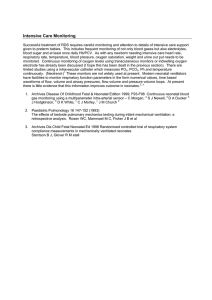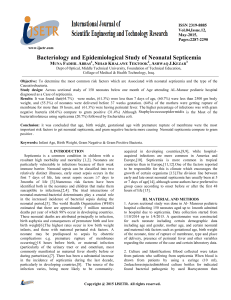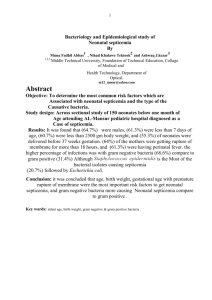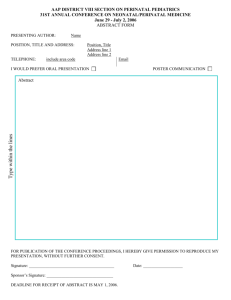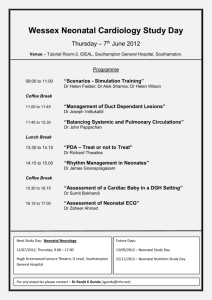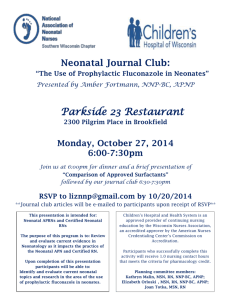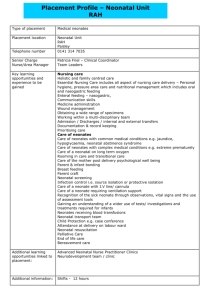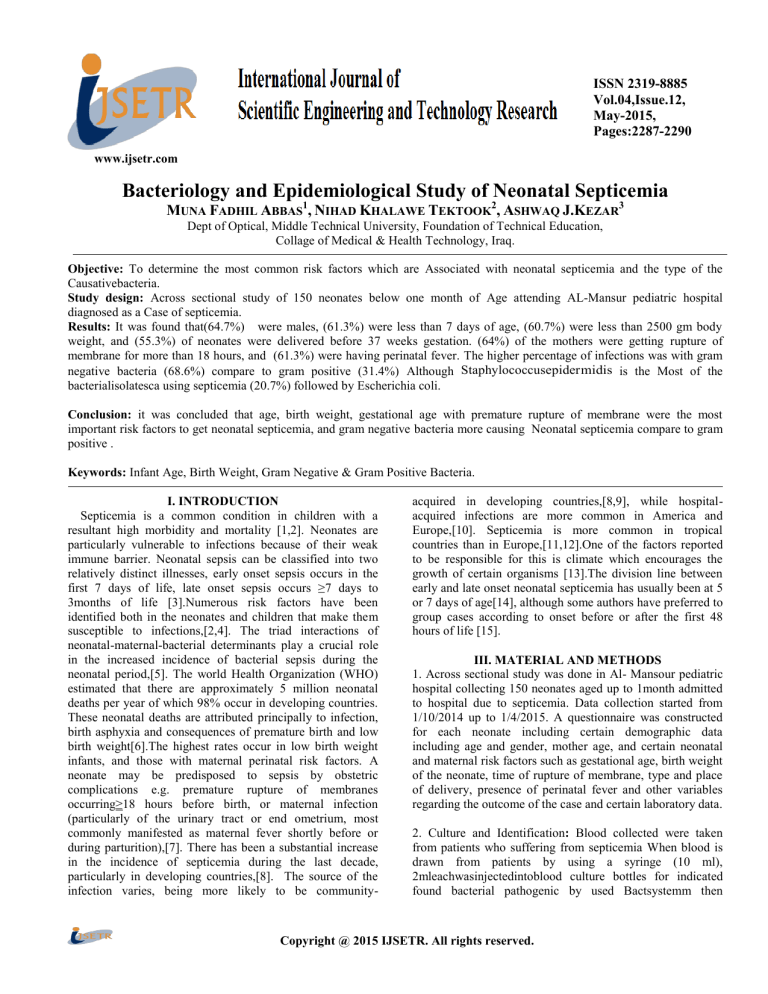
ISSN 2319-8885
Vol.04,Issue.12,
May-2015,
Pages:2287-2290
www.ijsetr.com
Bacteriology and Epidemiological Study of Neonatal Septicemia
MUNA FADHIL ABBAS1, NIHAD KHALAWE TEKTOOK2, ASHWAQ J.KEZAR3
Dept of Optical, Middle Technical University, Foundation of Technical Education,
Collage of Medical & Health Technology, Iraq.
Objective: To determine the most common risk factors which are Associated with neonatal septicemia and the type of the
Causativebacteria.
Study design: Across sectional study of 150 neonates below one month of Age attending AL-Mansur pediatric hospital
diagnosed as a Case of septicemia.
Results: It was found that(64.7%) were males, (61.3%) were less than 7 days of age, (60.7%) were less than 2500 gm body
weight, and (55.3%) of neonates were delivered before 37 weeks gestation. (64%) of the mothers were getting rupture of
membrane for more than 18 hours, and (61.3%) were having perinatal fever. The higher percentage of infections was with gram
negative bacteria (68.6%) compare to gram positive (31.4%) Although Staphylococcusepidermidis is the Most of the
bacterialisolatesca using septicemia (20.7%) followed by Escherichia coli.
Conclusion: it was concluded that age, birth weight, gestational age with premature rupture of membrane were the most
important risk factors to get neonatal septicemia, and gram negative bacteria more causing Neonatal septicemia compare to gram
positive .
Keywords: Infant Age, Birth Weight, Gram Negative & Gram Positive Bacteria.
I. INTRODUCTION
Septicemia is a common condition in children with a
resultant high morbidity and mortality [1,2]. Neonates are
particularly vulnerable to infections because of their weak
immune barrier. Neonatal sepsis can be classified into two
relatively distinct illnesses, early onset sepsis occurs in the
first 7 days of life, late onset sepsis occurs ≥7 days to
3months of life [3].Numerous risk factors have been
identified both in the neonates and children that make them
susceptible to infections,[2,4]. The triad interactions of
neonatal-maternal-bacterial determinants play a crucial role
in the increased incidence of bacterial sepsis during the
neonatal period,[5]. The world Health Organization (WHO)
estimated that there are approximately 5 million neonatal
deaths per year of which 98% occur in developing countries.
These neonatal deaths are attributed principally to infection,
birth asphyxia and consequences of premature birth and low
birth weight[6].The highest rates occur in low birth weight
infants, and those with maternal perinatal risk factors. A
neonate may be predisposed to sepsis by obstetric
complications e.g. premature rupture of membranes
occurring≥18 hours before birth, or maternal infection
(particularly of the urinary tract or end ometrium, most
commonly manifested as maternal fever shortly before or
during parturition),[7]. There has been a substantial increase
in the incidence of septicemia during the last decade,
particularly in developing countries,[8]. The source of the
infection varies, being more likely to be community-
acquired in developing countries,[8,9], while hospitalacquired infections are more common in America and
Europe,[10]. Septicemia is more common in tropical
countries than in Europe,[11,12].One of the factors reported
to be responsible for this is climate which encourages the
growth of certain organisms [13].The division line between
early and late onset neonatal septicemia has usually been at 5
or 7 days of age[14], although some authors have preferred to
group cases according to onset before or after the first 48
hours of life [15].
III. MATERIAL AND METHODS
1. Across sectional study was done in Al- Mansour pediatric
hospital collecting 150 neonates aged up to 1month admitted
to hospital due to septicemia. Data collection started from
1/10/2014 up to 1/4/2015. A questionnaire was constructed
for each neonate including certain demographic data
including age and gender, mother age, and certain neonatal
and maternal risk factors such as gestational age, birth weight
of the neonate, time of rupture of membrane, type and place
of delivery, presence of perinatal fever and other variables
regarding the outcome of the case and certain laboratory data.
2. Culture and Identification: Blood collected were taken
from patients who suffering from septicemia When blood is
drawn from patients by using a syringe (10 ml),
2mleachwasinjectedintoblood culture bottles for indicated
found bacterial pathogenic by used Bactsystemm then
Copyright @ 2015 IJSETR. All rights reserved.
MUNA FADHIL ABBAS, NIHAD KHALAWE TEKTOOK, ASHWAQ J.KEZAR
identification of Isolated Bacteria by Colonial morphology of
threefold [5], but was more than those seen in I Roy et al
grown bacteria on culture media, Colony size, color,
study in which they found that(28.9%) had a premature
elevation, edges, hemolysis on blood agar, IMVIC Test, API
rupture of membrane[19].(61.3%) were attending antenatal
20 E Micro Tubes System (Fischbach, 2001) and used Vitek2
clinic during pregnancy and 89 (59.3%) were receiving
system, which
is an automated microbiology system
tetanus toxoid at least 2 doses and (51.3%) were breast fed
utilizing growth-based technology. The system is available in
exclusively, this indicate a good educational standard of the
three formats (VITEK 2 compact, VITEK 2, and VITEK 2
mothers. Also it was found that (61.3%) were having
XL) that differ in increasing levels of capacity and
perinatal fever which is much higher than that seen in I Roy
automation. All three systems accommodate the same
et al study in which it was found that 5.2% of the mothers
colorimetric reagent cards that are incubated and interpreted
showed perinatal fever, [19].
automatically.
Table2. Frequencies & Percent of the maternal
3. Analysis of the data was done by using SPSS Package
Parameters
program. Frequencies and percent of the studied parameters
were done, and categorical data were compared using Chisquared test. Differences were considered to be statistically
significant at P<0.05.
III. RESULTS AND DISCUSSION
Septicemia still remained a very important cause of
morbidity among neonates, this may be due to immaturity of
the immune system and abnormal phagocytic function,[16].
In table1, One hundred fifty cases of neonatal septicemia
were collected, of which (64.7%) were malesand (35.3%)
were females,( male to female ratio 1.8:1),this result
resemble that seen in AO Mokuolu et al and O.O.Ayoola et al
studies in Nigeria in which they found that male to female
ratio was 1.2:1 and 1:1.1 respectively which is of nonsignificant effect [17],[18]. Also It was found that (61.3%) of
the sample were less than 7 days of age, which is higher than
AO Mokuolu study in which it was found that (49.2%) were
less than 7 days,[17]. Regarding birth weight it was found
that (60.7%) were less than 2500 gm, and the gestational age
(55.3%) of neonates were delivered preterm, less than 37
weeks gestation and (44.7%) were delivered full term, This
results is in consistent with I Roy et al study in which they
found that birth weight and gestational age were an important
risk factors for development of neonatal septicemia,[19].
Table1. Frequencies & Percent of the neonatal
Parameters
* N.V.D. = Normal vaginal delivery
** C.S. = Caesarean section
Certain investigation was done for each neonate such as
hemoglobin level, C.Reactive protein and culture of the
blood to show the type of the microorganism the infant
infected with, and the outcome of each case, (see table 3). It
was found that(70%) of the sample were of normal
hemoglobin level, (28%)were of low Hb, (41%) were with
positive C Reactive protein, while in M Douraghi et al study
they found that more than half of the neonates with
septicemia had positive C Reactive protein [5].
Table3. Investigations done to each infant and the
outcome results
Table2 reveals the maternal parameters. It was found that
(72%) were more than 20 years of age, (74%) were delivered
with normal vaginal delivery, (64%) were getting rupture of
membrane for more than 18 hours, this agree with M
Douraghi et al study in which it was found that premature
rupture of membrane affected the sepsis risk to more than
International Journal of Scientific Engineering and Technology Research
Volume.04, IssueNo.12, May-2015, Pages: 2287-2290
Bacteriology and Epidemiological Study of Neonatal Septicemia
*D.P.R. = Discharge on parents responsibility
neonates is still immature, which let them more susceptible to
The outcome was shown that (58.7%)were discharged in
infection, while gender showed no effect.
good condition while (16%) were died, and the rest were
discharged on their parents' responsibility(25.3%).This result
Table5. Correlation ship of the neonatal parameters with
is higher than that seen in a study done by Lepage et al[9] in
the outcome of the case by (Contingency- coefficients)
which they found that mortality rate was 9.3%, and in
Rwanda and Akpede et al it was 14.3% mortality [8], while
in O.O.Ayoola et al study they found that 69.2% were
recovered, 25.7% were died and 5.1% were discharged on
their parents' responsibility[18], and in Alausa et al [20]they
reported 38.4% mortality figures which are higher than that
what was seen in this study, this may be due to different
causative organisms with varying degree of severity of
infection and complications which is also affected with the
climate that encourage growth ofcertain microorganisms
[13]. In the same table it was found that the higher
percentage of infections was with gram negative bacteria
(68.6%) and (31.4%) was gram positive. This result agree
with a research done by S.I. Nwadioha, E.O.P.Nwokedi, et al
in which they found that g-ve bacteria were 69.3% of the
total isolates and g+ve were 30.7%[21].Also in O.O.Ayoola
et al[18], and in USA the gram negative organisms were
In table 6 the correlation ship between maternal parameters
isolated in (60%) of patients[22], and 66% of isolates
and the outcome, in which it was found that the time of
documented in east Africa was also gram negative [23].
rupture of membrane showed highly significant association
According to the frequency of affection (table 4) showed that
with the outcome of the case, P less than0.005 and there is a
Staphylococcusepidermidiscomprise the higher percentage
significant correlation with the type and place of delivery,
of infection (20.7%), Escherichia coli(18.7%), Enter obacter
P=0.027 and 0.032 respectively, while the presence of
spp (16%) then Klebsiella spp (15.3%), Pseudomonas
perinatal fever showed no correlation, P = 0.229. this result is
aeruginosa(12.7%), Staphylococcus aureus (10.7%)and the
consistent with M Douraghi et al research in which they
least was Proteus mirabilis(6%)
found that premature rupture of membrane affected the sepsis
risk to more than threefold.
Table4. Types of Bacteria Isolated from Blood Culture of
Septicemic Neonates
Table6. Correlation ship of the maternal parameters with
the outcome of the case by(Contingency- coefficients)
IV. CONCLUSION
It was concluded that as smaller the infant for age (<7
Table 5 reveals the correlation ship of the outcomes of the
days) and weight (<2500gm) is more prone to have
case with the neonatal parameters. It was found that age,
septicemia, also the more the baby delivered with gestational
birth weight, and gestational age of the neonate showed
age less than 37 weeks he is more vulnerable to get infection
highly significant effect on the outcome of the cases, P value
due to low immune system. Also it was concluded that
less than 0.005; this result was expected as the immune
premature rupture of membrane lead to more infection to the
system of young age, low birth and prematurely delivered
fetus.
International Journal of Scientific Engineering and Technology Research
Volume.04, IssueNo.12, May-2015, Pages: 2287-2290
MUNA FADHIL ABBAS, NIHAD KHALAWE TEKTOOK, ASHWAQ J.KEZAR
[18] O.O.Ayoola, A.A.Adeyemo and K.Osinusi. Aetiological
V. REFERENCES
[1] OgunleyeVO,OgunleyeAO,Ajuwape ATP, Olawole OM,
agents, clinical features and outcome of septicaemia in
Adetosoye A(2005). Childhood septicaemia due to
infants in Ibadan. WAJM Vol, 22.No1January-March 2003.
salmonella species in Ibadan, Nigeria. Afr. J. Biomed. Res. 8:
[19] I Roy, A Jain, M Kumar, SK Agarwal. Bacteriology of
131-134.
neonatal septicaemia ina tertiary care hospital of Northern
[2] Meremkwer MM, Nwachukwu CE, Asquo AE,
India. Indian Journal of MedicalMicrobiology, (2002) 20
OkebeJ,Utsalo SJ, Bacterial isolates from blood cultures of
(3): 156-159.
children with suspected septicemia in calabar, Nigeria. BMC
[20] Alausa KO, Onile BA. The Epidemiological patternof
Infect Dis 2005; 5: 110-5.
bacterial Septicemia at the University College Hospital,
[3] Edwards MS. Postnatal bacterial infections.In:NeonatalIbadan.Nig Med J 1984; 14: 55-62.
Perinatal Medicine.Fanaroff, Martins(editors). 8th ed.
[21]
S.I.Nwadioha,
E.O.P.
Nwokedi,
E.Kashibu,
Philadelphia, Mosby Elsevier 2006;Pp:791-804.
M.S.Odimayo and E.E. Okwori. A review of bacterial
[4] Guerina NG. In: Manualof neonatal care, 4th ed. (eds)
isolates in blood cultures of children with suspected
Cloherty JP, Stark AR (Lippincott- Raven, Philadelphia)
septicemia in a Nigerian tertiary Hospital. African journal of
1998; 271-299.
Microbiology Research Vol.4 pp 222-225, 18 February 2010.
[5] M Douraghi, MN Rostami, H Goudarzi, M-M
[22] Matin CM, Giomo AJ, Geraghty MJ, Zager JR, Mandes
Soltandallal, M Radfar and H Zeraati. Risk of neonatal
JC. Gram negative rod bacteraemia. J Infect Dis 1969; 119septicemia associated with neonatal-maternal-bacterial
506.
determinants. Sepsis 2010 critical care 2010, 14(suppl2):p7
[23] Harper MB, Fleisher GR. Occult bacteraemia in the 3
http:// ccforum. Com/ content/ 14/S2/P7.
month old to 3 year old age group. Pediatr Ann 1993; 22:
[6] WHO (1996).Perinatal mortality. Report No: WHO/FRH/
484, 487-493.
MSM/967. Geneva septicemia in Calabar, Nigeria. BMC
[24] Fischbach; Frances. Amanual of Laboratory and
Infect.Dis 2005; 5;110-5.
Diagnostic Test,2001, Edition 7. P: 164 – 170. Chapter 3.
[7] Beer Mark H, Porter Robert S.,Jones Thomas V.
Kaplan Justin L. Berkwits Michael. The Merck Manual of
diagnosis and therapy, 18th Edition 2006.Section 19
pediatrics, Neonatal sepsis p2333-2338.
[8] Akpede GO, Abiodun PO, Sykes RM. Acute fevers of
unknown origin in young children in thr tropics. J
Paediatr.1993; 122: 79-81.
[9] Lepage P, Nogaerts J, Van GoethemC,Ntahorutaba M,
Nsengumuremyi F, Hitimana D, Vandepitte J,ButzlerJ,
LevyJ. Community-acquired bacteraemia in African
Children. Lancet 1987-1; 1458-1461.
[10] Editorial: Septicemia on the increase. BMJ 1974; 4:
615.
[11] Dershewitz RA, Wigder HN, Wigder CM, Nadelnan
DH. Acomparative study of the prevalence, outcome and
prediction of bactraemia in children. J Paediatr 1983; 03:
352-358.
[12] Akpede GO, Adeyemi O, Ambe JP. Trends in the
susceptibility to Antimicrobial drugs of common
pathogen in childhood septicemia in Nigeria: experience
at the University of Malduguri Teaching Hospital,
Nigeria.1991-1994. Int J Antimicrob Agents 1995; 6: 9197.
[13] Berkowitz FE. Bacteraemia in hospitalized black
South African children. Am J Dis Child 1984; 138: 551556.
[14] Baker CJ, Group B streptococcal infections in
neonates, Pediatrics in Review 1979; 1: 5-15.
[15] PlaczekMM,Whitelaw A. Early and late neonatal
septicaemia.Arch DisChild 1983; 58: 728-31.
[16] Kearns AM,Ingham HR, Cant AJ, Spickett GP,
Breathnach AS. Abnormalphagocytic function in children
under one year of age. J. Infect. 1996; 32:103-107.
[17] AO Mokuolu, N Jiya and OO Adesiyun. Neonatal
septicaemia in Ilorin: bacterialpathgens and antibiotic
sensitivity pattern. Afr. J. Med. Med. Sci (2002) 31, 127130.
International Journal of Scientific Engineering and Technology Research
Volume.04, IssueNo.12, May-2015, Pages: 2287-2290

